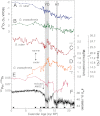Impact of abrupt deglacial climate change on tropical Atlantic subsurface temperatures
- PMID: 22908256
- PMCID: PMC3437837
- DOI: 10.1073/pnas.1207806109
Impact of abrupt deglacial climate change on tropical Atlantic subsurface temperatures
Erratum in
- Proc Natl Acad Sci U S A. 2012 Nov 13;109(46):19034. J, Link [corrected to Ji, Link]
Abstract
Both instrumental data analyses and coupled ocean-atmosphere models indicate that Atlantic meridional overturning circulation (AMOC) variability is tightly linked to abrupt tropical North Atlantic (TNA) climate change through both atmospheric and oceanic processes. Although a slowdown of AMOC results in an atmospheric-induced surface cooling in the entire TNA, the subsurface experiences an even larger warming because of rapid reorganizations of ocean circulation patterns at intermediate water depths. Here, we reconstruct high-resolution temperature records using oxygen isotope values and Mg/Ca ratios in both surface- and subthermocline-dwelling planktonic foraminifera from a sediment core located in the TNA over the last 22 ky. Our results show significant changes in the vertical thermal gradient of the upper water column, with the warmest subsurface temperatures of the last deglacial transition corresponding to the onset of the Younger Dryas. Furthermore, we present new analyses of a climate model simulation forced with freshwater discharge into the North Atlantic under Last Glacial Maximum forcings and boundary conditions that reveal a maximum subsurface warming in the vicinity of the core site and a vertical thermal gradient change at the onset of AMOC weakening, consistent with the reconstructed record. Together, our proxy reconstructions and modeling results provide convincing evidence for a subsurface oceanic teleconnection linking high-latitude North Atlantic climate to the tropical Atlantic during periods of reduced AMOC across the last deglacial transition.
Conflict of interest statement
The authors declare no conflict of interest.
Figures




References
-
- Zhang R. Anticorrelated multidecadal variations between surface and subsurface tropical North Atlantic. Geophys Res Lett. 2007;34:1–6.
-
- Zhang R, Delworth TL, Held IM. Can the Atlantic Ocean drive the observed multidecadal variability in Northern Hemisphere mean temperature? Geophys Res Lett. 2007;34:1–6.
-
- Chang P, et al. Oceanic link between abrupt changes in the North Atlantic Ocean and the African monsoon. Nat Geosci. 2008;1:444–448.
-
- Otto-Bliesner BL, Brady EC. The sensitivity of the climate response to the magnitude and location of freshwater forcing: Last glacial maximum experiments. Quat Sci Rev. 2010;29:56–73.
-
- Wen CH, Chang P, Saravanan R. Effect of Atlantic meridional overturning circulation changes on tropical Atlantic sea surface temperature variability: A 2 1/2-layer reduced-gravity ocean model study. J Clim. 2010;23:312–332.
Publication types
MeSH terms
Substances
LinkOut - more resources
Full Text Sources
Medical
Molecular Biology Databases
Miscellaneous

